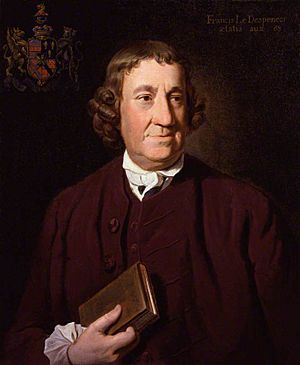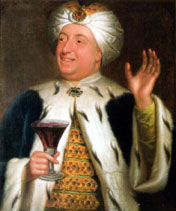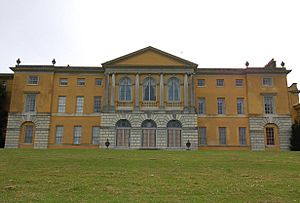Francis Dashwood, 11th Baron le Despencer facts for kids
Quick facts for kids
The Lord le Despencer
|
|
|---|---|
 |
|
| 2nd Postmaster-General | |
| In office 1765–1781 |
|
| Prime Minister | Various |
| Preceded by | The Earl of Bessborough |
| Succeeded by | The Viscount Barrington |
| Master of the Great Wardrobe | |
| In office 1763–1765 |
|
| Monarch | George III |
| Preceded by | The Earl Gower |
| Succeeded by | The Earl of Ashburnham |
| Chancellor of the Exchequer | |
| In office 1762–1763 |
|
| Prime Minister | The Earl of Bute |
| Preceded by | The Viscount Barrington |
| Succeeded by | George Grenville |
| Treasurer of the Chamber | |
| In office 1761–1762 |
|
| Monarch | George III |
| Preceded by | Charles Townshend |
| Succeeded by | Sir Gilbert Elliot |
| Member of Parliament for New Romney |
|
| In office 1741–1761 |
|
| Preceded by | Sir Robert Austen |
| Succeeded by | Thomas Knight |
| Personal details | |
| Born | December 1708 Westminster, Middlesex, England |
| Died | 1 December 1781 West Wycombe, Buckinghamshire, England |
| Political party | Tory |
| Spouse |
Sarah Gould
(m. 1745) |
| Children | Rachel Fanny Antonina Lee (illegitimate) |
| Parents | Sir Francis Dashwood, 1st Baronet Lady Mary Fane |
| Education | Eton College |
Francis Dashwood, 11th Baron le Despencer (born December 1708 – died 11 December 1781) was an important English politician. He served as Chancellor of the Exchequer from 1762 to 1763. He was also known for starting a social group called the Hellfire Club.
Contents
Life and Career
Early Life and Family
Francis Dashwood was born in London in December 1708. His father was Sir Francis Dashwood, 1st Baronet. His mother was Mary Fane. Francis was their only son. He also had a sister named Rachael. His father had other children from different marriages, so Francis had six half-siblings.
Francis went to Eton College for his education. There, he became friends with William Pitt the Elder, who would later become a famous politician. When his father passed away in 1724, Francis was only fifteen. He inherited his father's lands and the title of Baronet of West Wycombe.
Grand Tours of Europe
As a young man, Dashwood traveled a lot around Europe. These trips were part of a tradition called the Grand Tour. Young, wealthy people would travel to learn about art, culture, and history.
He visited France and Germany in 1726. Later, from 1729 to 1731, he spent two years traveling. During this time, he visited Italy, including Florence and Rome. He also saw the ancient ruins at Herculaneum. In Italy, he met a philosopher named Antonio Niccolini.
In 1733, Dashwood traveled to St Petersburg in Russia and also visited Copenhagen. He kept a detailed diary of this trip. This diary gives us important information about these cities at that time.
Dilettanti Society and Divan Club
In 1732, Dashwood helped create a social group called the Society of Dilettanti. This club was for people who had returned from their Grand Tours. They shared a love for classical art. William Hogarth, a famous artist, even drew a picture of Dashwood for the society. Dashwood was a very important member of this group.
The Dilettanti Society also became more serious over time. Dashwood's work with the society led to him becoming a Fellow of the Royal Society (FRS) in 1746. He also became a member of the Society of Antiquaries of London in 1769. These groups focused on science and history.
In 1744, Dashwood and his friend the Earl of Sandwich started another club called the Divan Club. This club was for people who had visited the Ottoman Empire. They wanted to share their travel stories. However, this club only lasted for two years.
Political Career
When Dashwood returned to England, he began his political career. He became a member of Parliament for New Romney in 1741. He often spoke out against the government of Robert Walpole.
In 1747, he tried to pass a bill to help poor people. He suggested creating public works projects, like the Hellfire Caves at West Wycombe Park, to provide jobs. However, this bill did not become law.
Dashwood continued to be re-elected to Parliament. In 1757, when the Seven Years' War began, he became the first colonel of the Buckinghamshire militia.
In 1761, he became a Member of Parliament for Weymouth and Melcombe Regis (UK Parliament constituency). The next year, he was appointed Chancellor of the Exchequer. This was a very important role, in charge of the country's money. However, he was not very experienced in finance. His budget speech was difficult to understand. He introduced a new tax on cider and perry, which caused a lot of protest.
In 1763, Dashwood left his role as Chancellor. He was then given the title of 11th Baron Le Despencer. This meant he became a member of the House of Lords. He also became Lord-Lieutenant of Buckinghamshire. He served as Postmaster General from 1770 to 1781.
The Hellfire Club
Francis Dashwood is well-known for founding a social club. He was too young to join the very first Hellfire Club from 1719. However, he and the Earl of Sandwich were said to be members of a Hellfire Club that met in the 1730s.
In 1746, Dashwood started his own group, which he called the "Knights of St. Francis." This name was a playful reference to his own name and to Saint Francis of Assisi. Dashwood wanted to create a fun group that was a bit of a joke on serious religious orders. He aimed for "convivial gaiety" and "social felicity."
In 1752, the group moved its meetings to Dashwood's family home in West Wycombe. They called themselves "the Order of the Friars of St. Francis of Wycombe." Later, they moved to Medmenham Abbey, about 6 miles from West Wycombe. Here, they were known as the "Monks of Medmenham."
Medmenham Abbey was an old building located by the Thames river. Dashwood rented it with some friends and family members. They had the buildings repaired by an architect named Nicholas Revett. The members would meet regularly, sometimes for a week or more.
The members of the club called each other "Brothers." The leader of the group was called "Abbot." During meetings, members reportedly wore special clothes. The club was known for its mock rituals and banquets. Dashwood also built a church on a nearby hill in West Wycombe.
Family
On 19 December 1745, Francis Dashwood married Sarah Gould. She was the widow of Sir Richard Ellis. Sarah passed away in 1769.
Francis Dashwood did not have any children who could inherit his title. After his death in 1781, the title of Baron Le Despencer was passed to his cousin, Thomas Stapleton. His baronetcy (another type of title) went to his half-brother, Sir John Dashwood-King.
Portrayal in Literature and Other Media
Francis Dashwood has appeared in various books and stories:
- Charles Brockden Brown in his 1798 novel Wieland
- J. Meade Falkner in his 1895 novel The Lost Stradivarius
- Robert Anton Wilson in his 1975 The Illuminatus! Trilogy and 1980–81 Schrödinger's Cat Trilogy
- James Herbert in the 1994 novel The Ghosts of Sleath
- Eddie Campbell in the 1994 comic book Hellblazer
- Kathy Reichs in the 2001 Novel Fatal Voyage
- Carrie Bebris in her 2005 Regency novel Suspense and Sensibility
- Mike Carey in the 2006 comic book Hellblazer
- Kage Baker in her 2007 short story "Hellfire at Twilight"
- Tom Knox in the 2009 novel The Genesis Secret
- Diana Gabaldon in her 1998 novella Lord John and the Hellfire Club
- Dashwood is mentioned in a longer version of the section "The Sailor's Hornpipe" on Mike Oldfield's debut album Tubular Bells.
See also
 In Spanish: Francis Dashwood para niños
In Spanish: Francis Dashwood para niños
- Dashwood baronets
- Baron le Despencer
- Dunston Pillar
- St Lawrence's Church, West Wycombe
- West Wycombe Caves
- West Wycombe Park



